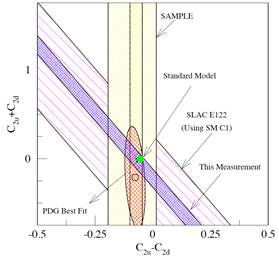Physics Division Research Highlights
Measurement of Parity Violation in Deep Inelastic Scattering
A triumph of modern physics is the unified description of the electromagnetic and weak interactions into a single framework known as the electro-weak Standard Model, or more commonly just as the Standard Model. This Standard Model very accurately predicts the results of many measurements, but even with this success, there is some evidence that it may not represent the complete picture of these interactions. To probe the Standard Model, a feature of the weak interaction—that it can violate parity conservation—was used. This feature can be observed in the laboratory by scattering polarized electrons. The rate that left- and right-handed electrons scatter from a target is different. In the case of deep inelastic scattering (DIS) this difference is of the order of 1 part in 10,000. The PVDIS experiment at Thomas Jefferson National Accelerator Facility (JLab) Hall A recently made a precise measurement of parity violation in deep inelastic scattering to measure the couplings of electrons to quarks. Specifically, the vector-electron to up (down) axial-quark coupling, known as C2u(d), was measured. The Standard Model predicts this quantity very precisely [1], but relevant measurements [2] of C2u(d) lack the precision of other parameters of the Standard Model. As shown by the blue band representing this recent high-precision measurement in the figure below, these new data confirm the predictions of the Standard Model, shown as a green point. While the precision of the new measurement is significantly better than all previous ones, the SoLID collaboration has proposed even more precise measurements with the JLab 12-GeV upgrade.

Figure 1: The results from the measurement of the quark weak axial charge combination shown as a function of C2u+C2d vs. C2u-C2d. This result is compared with previous measurements [2], a fit to all prior measurements by the Particle Data Group [1] and the prediction of the Standard Model.
Refenerences
[1] J. Beringer et al. (particle Data Group), Phys. Rev. D86 010001 (2012).
[2] C. Y. Prescott, et al., Phys. Lett. B77, 347 (1978), C. Y. Prescott, et al., Phys. Lett. B84, 524 (1979), and E. J. Beise, M. L. Pitt, D. T. Spayde, Prog. Part. Nucl. Phys. 54, 289 (2005).
![[Argonne Logo]](/images/argonne_header_logo.jpg)
![[DOE Logo]](/images/header_doe.gif)